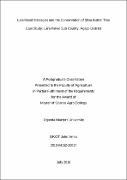| dc.description.abstract | This study sought to examine the influence of livelihood strategies towards the conservation
of Shea butter tree in Lira Palwo, Agago District. The influence of the changes in livelihood
strategies seemed to have a big impact on the conservation of Shea Butter Trees. This trend
left one wondering how the transformed livelihood strategy among the population has
affected sustainable utilization of SBT. The objectives included; to find out the influence of
existing structures and processes in transforming vulnerability context of communities into
sustainable livelihood strategies, the different roles played by actors in influencing
communities to select the livelihood strategies and the conservation outcomes of Shea butter
trees resulting from the different livelihood strategies transformed from the vulnerability
context in Lira Palwo Sub County.
This research study used several methods to deal with the research problem. Across sectional
qualitative approach was used in this study. In this study qualitative approach involved the
use and collection of a variety of empirical materials by in-depth interview and focus group
discussions. In order to explore the research questions and to elicit in-depth information on
the livelihood strategies towards the conservation of Shea butter trees, this study was
informed by primary and secondary sources. This study collected primary data and secondary
sources data using methodological/tools of interviews, observations and documentary
analysis. Approaches to the presentation and analysis of data were also discussed. Ethical
issues relating to this study were presented and discussed.
The conservation of natural resources was a contribution of every stakeholder in the
community including the cultural leaders, the government and the community at large, but
due to the high rate of urbanization, commercialization of agriculture, education and cultural
integrations, as well as political differences, the culture of togetherness has died, hence
affecting the survival of Shea butter and other natural resources in the area. Government,
traders, agricultural extension workers, environmentalist and forestry regulatory authorities,
were cited not to play their role in the conservation of Shea butter.
Using the findings, the study recommends the need to support the community to develop
consensus on the required natural resources to be left alive even if it’s a personal property to
survive the natural resources. | en_US |


